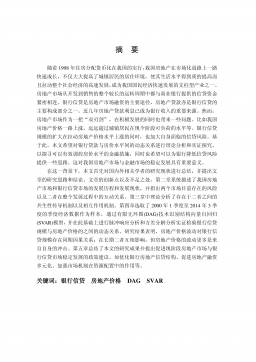无线传感器网络基于分簇的多路径可靠路由传输机制研究
VIP免费
摘 要
无线传感器网络(WSN)作为一种新的无线网络控制技术,经过多年的快速发
展,现已应用于军事侦察、医护监控、森林保护、城市交通优化以及物流仓库管
理等多个领域并且获得了良好的效果。WSN 网络中的数据传输的可靠性一直是衡
量网络性能优劣的关键问题,对网络的监测性能有着重要的影响。本文基于人工
免疫克隆选择机制以及网络编码机制,对相关分簇的多路径可靠路由机制进行了
研究。
首先,针对当前国内外人工免疫克隆选择机制、多路径可靠路由传输机制等
基本问题进行了综述,指出了目前发展的现状和存在的问题以及将来的发展方
向。接着,对当前研究比较热的可靠路由传输机制和相关网络调度优化的分簇算
法进行了介绍和比对,为本文基于免疫克隆选择机制的节点调度算法和基于网络
编码的多路径路由算法奠定了理论基础。进而对可靠数据传输的相关问题深入的
进行了研究,针对无线传感器网络节点分布不均匀,监测环境复杂等特点,节点
的调度不合理,并且容易导致网络覆盖面积不足,网络可靠性不高等缺点提出了
基于免疫克隆选择机制的具有分簇思想的 WSN 节点调度算法,另一方面,为了
实现基于数据收集的 WSN 网络中数据的收集率保持较高的效果,同时延长系统
的生命周期,提出一种基于网络编码的边旅行多路径路由协议,主要研究内容与
结果如下。
在网络节点调度优化方面,提出一种启发式的基于人工免疫克隆选择机制的
多路径节点调度优化算法(AICSO),将网络生命期划分为具体数量的迭代周期并
生成中心节点的覆盖位图,在这些位图的基础上调度节点状态,降低网络能耗并
获得网络的高可靠性、最优连通性和最大面积的覆盖。最后用 Matlab 进行仿真,
实验结果表明本算法通过节点调度的优化能够有效地最大化利用网络节点的能量
满足感知覆盖和连通性要求,延长了网络的寿命,同时降低了整体能耗。
在数据采集的可靠性方面,基于数据收集的 WSN 网络中,远离汇聚节点的
节点往往中继较少的分组。提出一种在空间上增强网络节点容错性的数据收集算
法称为“基于网络编码的边旅行(STNC)”算法,通过实现内部流异或网络编码来
减少冗余的数据包同时不显著的影响系统的寿命。最后对该算法的性能进行了评
估,结果表明,该算法能够为 WSN 网络提供可靠的服务质量。
最后对全文的研究内容进行总结,指出研究工作中存在的不足,并进一步明
确了以后的研究方向。
关键词:无线传感器网络 分簇算法 多路径路由 可靠传输
ABSTRACT
WSN (Wireless Sensor Network) is a new measure and management network
technology. After many years’ research and development, WSN has been applied in lots
of fields such as military affairs reconnaissance, medical treatment guarding, traffic
management, storage management. As one important problem in wireless sensor
networks, reliable data delivery determine show data packets can be delivered to Sink
successfully through multi hop routing. Based on the artificial immune clone selection
mechanism and network coding mechanism, we research the multipath reliable routing
transmission protocol.
First, we give an overview of the abroad and home basic problem about the
artificial immune clone selection mechanism and the multipath reliable transmission
mechanism, point out the current development situation and existing problems and the
future development direction. Then, we give a detailed introduction and comparison
about reliable routing transmission mechanism and clustering algorithm which are the
hot research fields. For the uneven distribution of nodes in WSN, monitoring
environment is complex, the nodes away from Sink often have large energy
consumption, and are easy to cause the network coverage area insufficient. From the
clustering algorithm based on immune clone selection mechanism and multipath routing
algorithm based on network coding we get a theoretical foundation. On the other hand,
the aim of this paper is to realize data-gathering WSN that keep the data collection ratio
as high as possible while keeping system lifetime as long as possible.
In the aspects of optimizing network coding scheduling, we propose an artificial
immune clone selection mechanism nodes scheduling optimization methods(AICSO), in
this way we will divide network lifetime to some specified number of iteration rounds
and in each round we will generate a coverage bitmap of sensors of the domain and
based on this bitmap it will be decided which sensors remain active or go to sleep. And
via topology control we will exploit the nodes’ redundancy which can decrease the
energy consumption to achieve desired level of connectivity and coverage in the
network. At last, we use Matlab simulation, and the simulation experiment shows the
method in this paper can effectively satisfy connectivity and coverage of the network,
prolong the network’s lifetime and save the network’s energy.
In the aspects of reliable data collection, we propose a multipath data gathering
protocol called “Side Trip with Network Coding (STNC)” scheme which utilizes inter-
flow XOR network coding to reduce redundant packets without affecting the system
lifetime significantly. In data-gathering WSN, nodes further from a sink node tend to
relay fewer packets. In the STNC scheme, redundant packets from different source
nodes are network-coded into an encoded packet in order to reduce the number of
redundant packets. The performance of the protocol is evaluated and the result shows
that this protocol can provide an available approach to QoS multi-path routing for WSN.
At last, we summarize the full contents and point out the insufficiency in our
research work then make the next step of research direction.
Key Word:Wireless Sensor Network, Cluster Routing Protocols,
Multi-path Routing, Reliable-data Transmission
目 录
中文摘要
ABSTRACT
第一章 绪 论 .................................................................................................................. 1
1.1 无线传感器网络概述 ........................................................................................... 1
1.2 课题研究现状 ....................................................................................................... 2
1.2.1 可靠路由传输机制的研究现状 ...................................................................... 2
1.2.2 免疫克隆选择机制研究现状 .......................................................................... 3
1.3 本文研究内容与目的 ........................................................................................... 3
1.4 本文章节安排 ....................................................................................................... 5
第二章 WSN 分簇的可靠路由传输机制 ....................................................................... 6
2.1 引言 ....................................................................................................................... 6
2.2 可靠路由传输机制的基本问题 ........................................................................... 6
2.2.1 可靠数据传输的基本需求 .............................................................................. 6
2.2.2 影响 WSN 网络数据可靠传输的因素 ........................................................... 7
2.2.3 WSN 网络数据可靠传输方法 ........................................................................ 7
2.3 WSN 网络节点分簇机制 .................................................................................... 11
2.3.1 WSN 网络节点分簇的基本概念及优势 ...................................................... 11
2.3.2 几种典型分簇算法的相关研究 .................................................................... 12
2.3.3 算法分析和评估 ............................................................................................ 15
2.4 本章小结 ............................................................................................................. 16
第三章 基于免疫克隆选择机制的 WSN 分簇节点调度的多路径算法 .................... 17
3.1 引言 ..................................................................................................................... 17
3.2 WSN 网络数学模型 ............................................................................................ 18
3.3 基于免疫克隆选择的节点调度算法 ................................................................. 21
3.3.1 免疫克隆选择机制原理 ................................................................................ 21
3.3.2 算法步骤 ........................................................................................................ 24
3.3.3 算法伪代码 .................................................................................................... 26
3.4 仿真分析和结果 ................................................................................................. 27
3.4.1 实验环境以及仿真平台 ................................................................................ 27
3.4.2 实验方案 ........................................................................................................ 28
3.4.3 实验结论及分析 ............................................................................................ 29
3.5 本章小结 ............................................................................................................. 31
第四章 一种基于网络编码的边旅行多路径路由协议 ............................................... 32
4.1 引言 ...................................................................................................................... 32
4.2 相关算法 .............................................................................................................. 33
4.3 STNC 算法描述 ................................................................................................... 33
4.4 STNC 算法相关定义及流程 ............................................................................... 39
4.5 算法性能评估 ...................................................................................................... 40
4.5.1 实验环境以及仿真平台 ................................................................................ 40
4.5.2 实验方案 ........................................................................................................ 41
4.5.3 实验结论及分析 ............................................................................................ 43
4.6 本章小结 .............................................................................................................. 46
第五章 总结和展望 ...................................................................................................... 47
参考文献 ........................................................................................................................ 48
在读期间公开发表的论文和承担科研项目及取得成果 ............................................ 52
致 谢 .............................................................................................................................. 53
第一章 绪论
1
第一章 绪 论
1.1 无线传感器网络概述
无线传感器网络(Wireless Sensor Network,WSN)[1]的研究始于上世纪 90 年代
末,随后 WSN 网络引起了各行业和相关领域的极大关注。WSN 网络也是影响全
世界未来生产和生活的高新技术,其内容涉及传感器、移动网络、分布式、现代
通讯、嵌入式以及微电子制造等多重技术,具有鲜明的跨学科的特点。由于
WSN 网络在军事战场、医疗环境、天气预测、交通管理和家庭使用等方面的广泛
应用,美国和欧洲各国都已启动了各种关于 WSN 网络的研究项目,并获得多方
资助以支持 WSN 网络技术的研究发展和推广。随着 WSN 网络技术不断深入的研
究和日益广泛的应用,WSN 网络已经逐渐深入到我们生活的方方面面。WSN 网
络在实际应用中出现的各种难题也为相关科研人员提供了广阔的研究空间。美国
在是最早开始这方面研究的国家并且投资规模巨大,而现在国内各领域关于
WSN 网络的研究也正如火如荼的发展起来。随着这项前沿技术研究的深入,将对
整个国家的军事、经济和民生等方方面面的发展产生不可估量的意义。
随着无线通信技术、嵌入式技术、微电子技术、计算机技术和传感器技术的
进步,WSN 网络也相应的获得了更多的技术支持和快速的发展。WSN 网络是由
监测范围内随机部署的若干传感器节点以无线通讯的方式连接而成的一种多跳自
组织的无线网络系统,其主要目的是协同的感知、收集和处理覆盖范围内相应感
知对象的事件信息,并最终将加工转换过的信息发回给观察者,以便观察者提取
有用信息。与传统的无线网络相比,WSN 具有分布式高并发处理、可快速部署、
大范围覆盖、可异地远程监控等众多优点,同时网络整体具有高容错性。
同时,WSN 网络也有许多不足之处。第一,传感器节点能量有限,鉴于检测
范围大而且实际环境复杂多变等因素,通过更换节点的电池补充电源是不实际
的。在 WSN 网络中节点能量的损耗主要分布在传感器、处理器和无线通讯这三
个模块,其中节点之间通信消耗的能量最为严重,因此如何高效的利用节点的能
量从而获得一个能耗均衡的分簇路由协议是延长网络生命周期关键问题。第二,
数据传输的可靠性是衡量 WSN 网络最基本的评判标准。为了保障收集到的数据
能够从数据源可靠地传回到 Sink 节点,同时避免丢包,WSN 网络必须做到数据
信息真实可靠。数据传输的可靠性是WSN 网络的基础,也是应对其他各种复杂
环境的根本,也一直是 WSN 网络研究的重点。
摘要:
展开>>
收起<<
摘要无线传感器网络(WSN)作为一种新的无线网络控制技术,经过多年的快速发展,现已应用于军事侦察、医护监控、森林保护、城市交通优化以及物流仓库管理等多个领域并且获得了良好的效果。WSN网络中的数据传输的可靠性一直是衡量网络性能优劣的关键问题,对网络的监测性能有着重要的影响。本文基于人工免疫克隆选择机制以及网络编码机制,对相关分簇的多路径可靠路由机制进行了研究。首先,针对当前国内外人工免疫克隆选择机制、多路径可靠路由传输机制等基本问题进行了综述,指出了目前发展的现状和存在的问题以及将来的发展方向。接着,对当前研究比较热的可靠路由传输机制和相关网络调度优化的分簇算法进行了介绍和比对,为本文基于免疫...
相关推荐
-
跨境电商商业计划书模版VIP免费

 2025-01-09 27
2025-01-09 27 -
跨境电商方案范文VIP免费

 2025-01-09 14
2025-01-09 14 -
创业计划书VIP免费

 2025-01-09 18
2025-01-09 18 -
xx生鲜APP计划书VIP免费

 2025-01-09 12
2025-01-09 12 -
跨境电商创业园商业计划书(盈利模式)VIP免费

 2025-01-09 8
2025-01-09 8 -
跨境电商计划书VIP免费

 2025-01-09 13
2025-01-09 13 -
绿色食品电商平台项目计划书VIP免费

 2025-01-09 22
2025-01-09 22 -
农产品电子商务商业计划书VIP免费

 2025-01-09 9
2025-01-09 9 -
农村电商平台商业计划书VIP免费

 2025-01-09 13
2025-01-09 13 -
生鲜商城平台商业计划书VIP免费

 2025-01-09 21
2025-01-09 21
作者:侯斌
分类:高等教育资料
价格:15积分
属性:56 页
大小:1.61MB
格式:PDF
时间:2024-11-19






